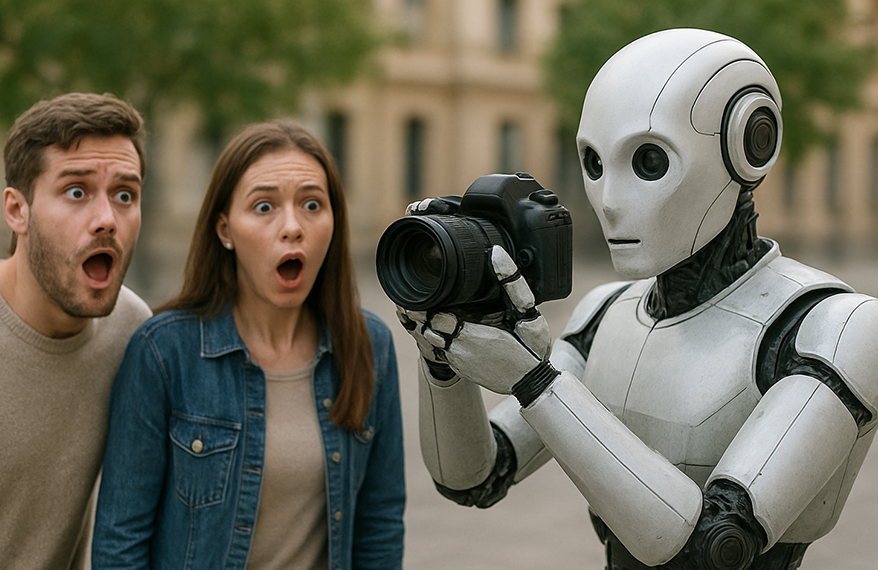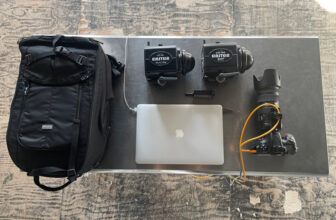
As Artificial Intelligence rapidly merges into our world, it’s driving profound shifts in the workplace and stepping into central roles.
I can’t help but wonder what this will mean for photographers and the future of our craft.
One important point to consider is how to explain the integration of AI into your photography to your clients.
You might not be prepared to discuss this issue with clients. However, ready or not, your clients are already wondering how you’re using it, or worse, considering whether they can replace you with AI.
Talking to your clients about how you use AI in the workplace will help dispel any of their unfounded concerns and misconceptions.
Clients might have unfounded ideas and prejudices about the use of AI, so I would suggest it’s important to put their minds at rest.
Read on to learn what common client misconceptions are brewing behind the scenes, and how to masterfully deal with them.
How to Reassure Clients About AI in Photography
Now the truth is that unless you have a unique photography practice, any photographer not using AI will be left far behind in a trail of manual editing dust.
If you haven’t already delved into the joys of AI editing, I’d suggest you start familiarizing yourself with it ASAP.
An AI-powered photography workflow is going to be more efficient, leaving you more time on the creative side.
Once you’re comfortable with the ways you’ve integrated AI in your photography, you can start to confidently answer your clients’ questions.
The first step to discussing AI with clients is to discern what their preconceived perceptions are.
When you have determined their stance on AI you can move forward and discuss it.
To discuss AI in your practices, you won’t need to delve into the details of algorithms or machine learning.
Instead, be thoughtful, be prepared, be honest, be knowledgeable, and be receptive.
AI: Your Client’s Friend or Foe?
Step one in this process is getting to understand how your clients feel about AI.
There are many different perceptions and perspectives on the use and integration of AI in the workplace.
I would suggest you don’t jump into a conversation without first gauging what each of your clients’ opinions of AI is.
You can quickly determine if AI is your client’s new guru or biggest foe. Are they curious about it, or do they have a mistrust of it?
They might even believe it’s possible to replace all professions with AI bots.
Understanding your client’s perspective is crucial. For example, if you rave on about the wonders of AI to a client who is fearful, you will exasperate their concerns instead of appeasing them.
In contrast, if you talk only of the advantages of AI to a client who thinks AI is the up-and-coming master of all, it might affirm their misconception that they don’t need a human photographer.
People are fickle; in a disposable society, it’s easy for people to jump to conclusions without assessing the situation.
Each client’s viewpoint requires a different conversation. Once you understand your client’s position, you can begin.
Your job is to provide clarity on the AI subject.
How Transparency Builds Client Trust Around AI
To embody true professionalism, I believe it’s essential to be as transparent as possible about all aspects of your work, and it’s no different with the use of AI.
Transparency builds trust, and trust is one of the key aspects to building lasting relationships with clients.
So when talking to clients, I advise being as transparent as possible. Who knows—try to hide your use of AI, and your client’s teenager might call it out, having already mastered AI detection tools.
To be transparent, I talk clients through how I incorporate AI into my work. This can be different for each photographer; it depends on your practice.


For example, when batch processing wedding photos, I use AI to crop and help create an album with a consistent look.
I explain what I use AI for, but I also explain what I do not use AI for.
For example, I do not use AI for creative direction. While AI might be able to help me perfect the image, it does not inspire the vision.
Plus, I do not use AI to create fake or unrealistic images. I prefer to retain original authenticity.
If I think a photo needs an added element, I will always discuss this first with the client.
Remember, clients already know you are using it, they just don’t know how.
Example: “AI is an indispensable asset in the workplace; it’s capable of incredible speed and precision. However, it does not make executive decisions on the direction of the project. It’s simply a useful tool.”
Demystifying the Unknown
Many people are left in awe of AI, and in truth, it is an incredible tool; however, it’s we humans who possess the artistic vision.
Remember, there is a lot of hype in the AI industry, and sometimes this hype is fueled by nothing more than marketing and clickbait.
We don’t know for sure how much the world will change with the use of AI, but one thing we do know is that AI is generating concerns, misunderstandings, and inflated biases.
Your clients will want to know that your professional skills still count. That it is you who holds AI by the reins—you are the master, not AI, not the other way around.
You will need to clarify that you are using AI as a tool, much like an assistant who is trained to assist with photo editing.
Example: “AI is an incredible asset to many professions, and it is no different in the photography industry. However, it has its limitations and is not capable of making unchecked edits.”
Dealing With Unfounded AI Mistrust
Some clients might be mistrustful of your control over AI. They could mistakenly believe the shots will not be an authentic representation, but instead an AI generation.
This type of client will think the photographer no longer has control, and AI will ruin their photos beyond recognition.
They might believe that you have surrendered to AI, and there is no personal professional skill involved.
They are worried that you put the photo in one end of a computing machine and AI spits it out the other, creating lower-quality fake renditions due to AI’s automation.
Luckily, you don’t need to be a tech head to explain how AI works to improve the image without contorting it.
You can explain that you use AI to apply filters, but this is very similar to the process you used before AI.


Explain how AI features intelligently adjust an image’s colors and lighting, but the original composition remains.
You can further put the client’s mind at rest by explaining that you always keep the original file. So if the client doesn’t like the image, there will be the option to revert.
Example: “AI will alter the image, similarly to how a photography assistant would. It applies edits to the photos, which I then review to decide if they are in line with the creative vision.”
Or: “I oversee all of the edits created using AI. I use AI as I would an assistant, not as an unchecked automation.”
Highlight the Value of AI
Explaining how they will benefit from AI can help apprehensive clients.
Let them know how AI streamlines editing tasks and spots inconsistencies that are not always detectable to the human eye.
Explain that the technical benefits, faster results, and editing precision allow you, the photographer, more time to be creative.
A word of caution here: Don’t overly focus on the values of AI. This could potentially undermine your role in the client’s eyes. AI enhances the process, it does not replace your skills.
Clients don’t want to pay a photographer who hands all tasks straight over to an up-and-coming robot.
They are coming to you for a photography service because they want the personal touch.
Example: “AI is a slick machine. I use it to increase time efficency and precision during my editing process, such as batch processing, intelligent filter overlays and color correction. This enhances my time management and editing accuracy and leaves me more time on the creative side.”
Or: “AI can cut corners, streamlining editing tasks and spotting inconsistencies that might go undetected by the human eye.”
Highlight Your Value as the Photographer
Now, there will be a handful of clients who are completely in awe of AI’s capabilities. These clients might think AI is now running the entire photography studio.
Due to this, they might have come to some unfounded conclusions, such as that they are overpaying you.
Make sure you highlight your value. Your human skills are not outdated and probably will not be anytime soon.
You could also explain the additional time costs of training AI to your standard (if you do), plus the added cost of AI subscriptions.
I would also make them aware of the areas where AI lacks human talent and capabilities.
However, if they are adamant that AI is cutting corners and therefore costs, consider if you want to work with a client who does not value you.


You can emphasize how the importance of the human eye and interaction in the photography practice hasn’t been replaced.
For example, a wedding photographer has the ability to spot and capture real moments – a mother’s tear, the bridesmaid’s laughter, or the groom’s adoring glances.
You as the photographer are the one with the professional skill to envision, direct, and capture a story – combining the perfect expression, light, and angle to capture the ultimate shot.
Example: “While AI can speed up certain editing processes, it cannot replace human artistic skill and the ability to capture unique moments.”
Or just go with: “It appears you don’t value human input, I suggest it might be worth you finding an AI bot to take your photos.”
AI and Privacy
Your client might have valid concerns that their images will be used by AI for machine learning or shared across the internet.
Since its release, AI has been in the hot spot for breaching privacy and confidentiality laws, so it’s reasonable for your client to be worried.
Stories like these have sparked realistic concerns that third-party groups will lay their mucky little AI hands on people’s private photos and use them inappropriately.
Nobody wants their likeness depicted strutting down the red carpet with some hot celebrity (ok maybe they do). But they definitely don’t want their likeness flaunted taking part in nefarious activities.
It will be important to put their mind at rest and explain how their photos will be protected. Explain that the AI you use cannot share images with third parties.
Privacy laws, copyright laws, and AI companies’ ethical policies ensure that people’s data is protected.
The Value of Human Connection
Your client might be concerned that AI is a super brain and there is no point hiring an outdated human. It’s very easy to dispel this belief.
How people interact with cameras isn’t purely them staring into a mechanical box; they are reacting to the photographer behind the camera.
The reason some photographers take exceptional portraits and others mediocre ones is down to how they connect with the subject.
Children and animals are the most difficult subjects to photograph. This is because they respond authentically; if they don’t like the cameraman, they will let everyone know.


I find that when photographing clients, the best photo isn’t taken in the first 5 minutes; it takes at least 10-15 minutes to warm people up. When they relax and trust me is when the portrait magic happens.
This is when the unique expressions, the gleaming eyes, the laughter or the sultry looks happen.
If photographic camera robots are introduced and start taking photos, how will their portraits look when they lack a human soul to connect to?
Client FAQs About AI in Photography
So what happens if your clients come to you with questions or worries about AI? Don’t worry – being prepared with clear, reassuring answers will help you build trust and show that you’re in control of the process.
Here are some Q&As you can use and adapt to make your own.
Q: Will AI make my photos look fake?
A: No. AI tools don’t replace your images or fabricate scenes. I use them to fine-tune details like lighting, color, and consistency – things that make your photos look more polished, not artificial. The original authenticity is always preserved.
Q: If you’re using AI, does that mean you spend less time on my project? Why am I paying the same?
A: AI saves me time on repetitive tasks like cropping or batch edits, but that doesn’t reduce the value of my work. It frees me to focus more on the creative side – directing, storytelling, and making sure your photos reflect your unique story. That’s something only a human photographer can deliver.
Q: Is my data safe when you use AI?
A: Absolutely. I only use professional, secure AI tools that don’t share or resell your images. Your photos are never fed into public training datasets. I also keep your original files safe and private.
Q: Can I request that you don’t use AI at all?
A: Yes, of course. My goal is to deliver photos you love and feel comfortable with. I’ll always be transparent about when and how I use AI, and if you’d prefer an AI-free workflow, I’m happy to adapt.
Q: Does AI mean photographers will eventually be replaced?
A: No. AI is a tool, not a replacement for creativity, human connection, or artistic vision. While it can speed up technical edits, it can’t capture emotions, direct a shoot, or tell a story the way a human photographer can.
Conclusion
Human skills are crucial in the photography workplace. Creativity, connection and artistic vision are central to the role of photographer and won’t be replaced by AI.
However, if you are not using AI tools now, you have your head stuck far too deep in quicksand.
Remember, the first step to talking to your clients is to ask what their thoughts on AI are. This will ensure that you don’t amplify any unfounded concerns.
How you initiate a conversation about AI will make a difference to the outcome, so make sure you build trust with your client.
Ensure that you also talk about how your skills and experience are essential in the photography practice.
We don’t want our integral creative role and expertise as photographers to be overlooked. Human connection and storytelling are essential to our practice.
Appease any concerns by letting your clients know that you don’t add imaginary elements or use AI filters to hide technical flaws, nor will their images be flaunted publicly on the internet.
You don’t need to go in-depth and explain code and machine learning, but outline AI’s technical skills and where it falls short.
Whether your client believes AI is a faultless genius with superior capabilities or if they’re nervous and fearful of it, you can dissipate any anxieties about AI by remaining honest, professional, and responsive.
Credit : Source Post






